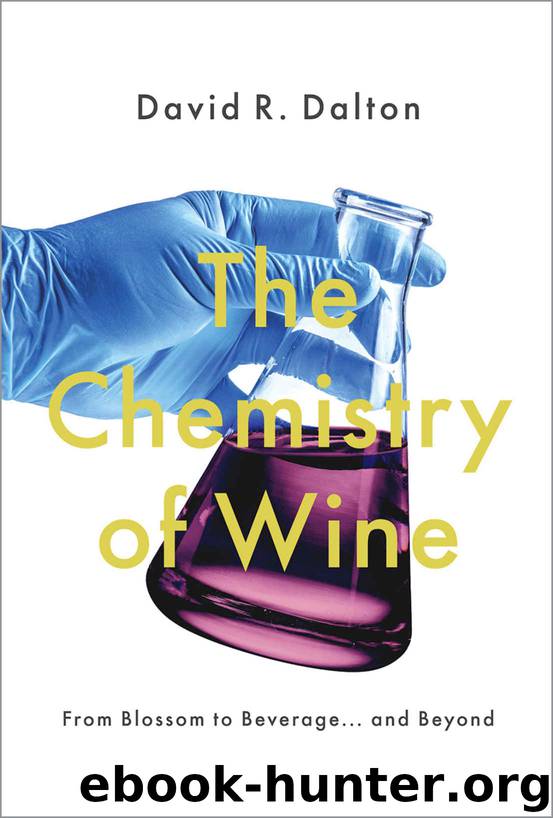The Chemistry of Wine: From Blossom to Beverage and Beyond by David R. Dalton

Author:David R. Dalton [Dalton, David R.]
Language: eng
Format: azw3
Publisher: Oxford University Press
Published: 2017-10-18T04:00:00+00:00
19
Finishing the Wine
THE END OF fermentation, signaled by density measurements, the alcohol-driven death of the Saccharomyces cerevisiae strain that was used, the cessation of evolution of carbon dioxide, and the generally accepted passage of the several weeks over which time the fermentation has been permitted to extend, is followed by the previously discussed (Chapter 16) process of racking.
The racking, as noted earlier, will separate most of the precipitated solids that are present or have developed during the fermentation process (e.g., accumulated seed and twig pieces not previously removed, insoluble carboxylic acid salts, dead yeast cells, and other solids [the lees]) from the fermented juice. But the wine may not yet be clear. Indeed, the wine may need racking once or twice more for clarification before a final filtration to produce the appropriate bright and clear beverage-quality wine. The last, or even a penultimate racking, might be done into an oaken vessel and should be done into oak if a red wine is being finished (European or American oaks are commonly used, but with different results, vide infra). However, it is important that regardless of the color of the wine each racking operation be done as carefully as possible to exclude transfer of solids and oxygen. At this stage of finishing, the oxygen will probably not be utilized in biochemical processes, barring the presence of microbial life, and normal oxidation of phenols and alcohols in the wine will have been inhibited by the presence of carbon dioxide (which replaced the oxygen in the solution during fermentation). Thus, if oxygen is introduced, it is likely that unwanted oxidation products might form.
The final racking for white wines (excluding Champagne, other “sparkling” wines, and some specialty beverages to be considered later) is generally carried out so that the beverage can rest for a few months (often with cooling to inhibit deleterious processes occurring as a result of aging) before filtering and bottling. If, on standing, the wine has not become clear enough (e.g., a haze remains), a fining agent such as bentonite, a silicate clay with additional interspersed cations (commonly monovalent potassium, K+, and/or sodium, Na+, divalent calcium, Ca2+, and/or magnesium, Mg2+, and trivalent aluminum, Al3+, and/or iron, Fe3+) or kaolin, a simple aluminum silicate clay, or even egg white can be added. Clay fining agents effect clarification by providing a large surface area to which the constituents of the haze can be attracted and cling; with egg white, a web of proteinaceous material to which the particles can cling and aggregate is formed.
With regard to the fining steps, it is important to recognize: (a) that additional chemistry continues to occur during the period of standing; (b) fining agents, used to carry away unwanted materials that have a deleterious effect on the beverage may also bring contaminants to the beverage that will change its taste; and (c) oxygen, heat, and light need to be avoided as they will change the wine. And, of course, the tank (glass, plastic, stainless steel, oak, etc.) in which the wine is allowed to stand before bottling will play a role and may change the wine too.
Download
This site does not store any files on its server. We only index and link to content provided by other sites. Please contact the content providers to delete copyright contents if any and email us, we'll remove relevant links or contents immediately.
101 Whiskies to Try Before You Die by Ian Buxton(44802)
World's Best Whiskies by Dominic Roskrow(44740)
Whiskies Galore by Ian Buxton(41881)
Craft Beer for the Homebrewer by Michael Agnew(18142)
Right Here, Right Now by Georgia Beers(4126)
Not a Diet Book by James Smith(3337)
Water by Ian Miller(3129)
The Coffee Dictionary by Maxwell Colonna-Dashwood(3067)
Kitchen confidential by Anthony Bourdain(3010)
Coffee for One by KJ Fallon(2567)
Smuggler's Cove: Exotic Cocktails, Rum, and the Cult of Tiki by Martin Cate & Rebecca Cate(2473)
Superfood Smoothie Bowls: Delicious, Satisfying, Protein-Packed Blends that Boost Energy and Burn Fat by Chace Daniella(2388)
Talking as Fast as I Can by Lauren Graham(2386)
Beer is proof God loves us by Charles W. Bamforth(2372)
Bourbon: A Savor the South Cookbook by Kathleen Purvis(2246)
A Short History of Drunkenness by Forsyth Mark(2234)
Eat With Intention by Cassandra Bodzak(2155)
Cocktails for the Holidays by Editors of Imbibe magazine(2082)
Colombia Travel Guide by Lonely Planet(2066)
